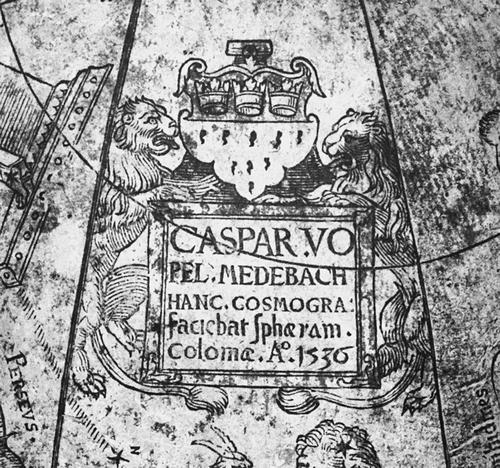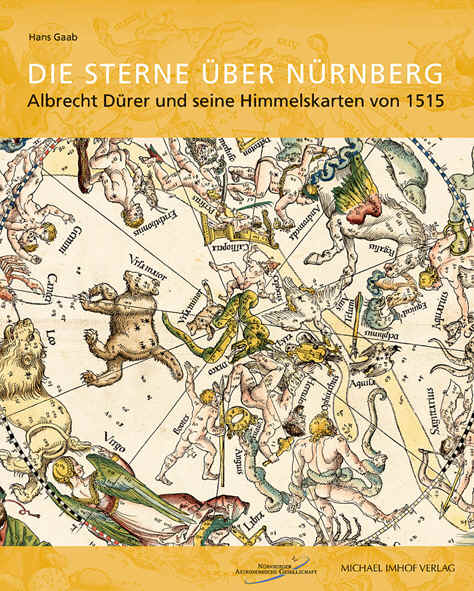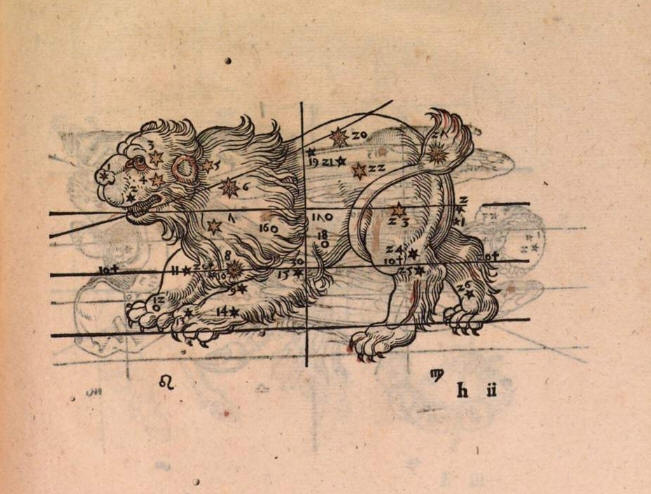
|
Anonimo (Vopel) |
SPHAERA / ASTRONOMICA / aeri exarata, sicut / eam olim exhibuit Cas/par Vopelius Cosmogr. quasi copia di Caspar Vopel, Caspar. VO / PEL. MEDEBACH / HANC. COSMOGRA: / sphæram faciebat. / Coloniae. UN. 1536 |
Anonimo
(Vopel)

SPHAERA / ASTRONOMICA / aeri exarata, sicut / eam olim exhibuit Cas/par Vopelius Cosmogr.
quasi copia di
Caspar Vopel

Caspar. VO / PEL. MEDEBACH / HANC. COSMOGRA: / sphæram faciebat. / Coloniae. UN. 1536
La
stampa da incisione su rame che presento è stata venduta all’asta da Sotheby
a Londra nel 2008, Catalogue Natural
History, Travel, Atlases and Maps ( Sale L08401), London , 8
May 2008.
E’
opera di un autore ancora anonimo e rappresenta un cielo quasi identico a quello
presentatoci da Caspar Vopel in un suo globo stampato a Colonia nel 1536.
I rapporti che legano le due opere ed i loro autori sono ancora tutti da ricostruire.
Elly Dekker le mette a confronto in un suo fondamentale articolo, che descrive la
produzione di Vopel, pubblicato nel 2010 sul numero 2 del volume 62 di Imago
Mundi: Elly Dekker, Caspar Vopel's
Ventures in Sixteenth-Century Celestial Cartography
http://www.atlascoelestis.com/Vopel%202010%20base.htm
L’incisione,
cm 92 x 44 circa, sviluppa in 12 spicchi il cielo riproducibile in un globo di
Nel suo articolo Dekker indica il globo di Vopel con la sigla G1 e con G2 l’incisione di anonimo. Di seguito trascrivo le caratteristiche di entrambi come sono riportate nell’articolo succitato:
G1. CELESTIAL GLOBE
Woodcut,
Ø sphere 29 cm , 1536. Cologne , Kölnisches Stadtmuseum.
Above Auriga [lon 75°,
lat 60°] is an inscription in a cartouche with the coat of arms of Cologne on
top and two lions at the sides: CASPAR.
VO/PEL. MEDEBACH / HANC. COSMOGRA: / faciebat sphæram. / Coloniæ. A°. 1536. South of the tail of Cetus [lon
345°, lat −60°] is an empty cartouche consisting of a
rectangular field with decorations around it.
Cartography
Language:
Latin. Coordinates: circles of latitude every 30° (gore edges). The ecliptic is
graduated [twelve times 0°–30°; numbered every 10°, division 1°]. The
boundaries of the zodiac are indicated by two parallels north and south to the
ecliptic. The symbols of the zodiacal signs are marked north of the zodiacal
constellations. The equator is graduated [0°–360°, numbered every 10°,
division 1°] and labelled: AEQVATOR. The tropics are drawn and
labelled: TROPICVS CANCRI and TROPICVS CAPRI :. The
polar circles are drawn, but not labelled. The colures are incompletely drawn
and not labelled.
Astronomical
notes
All
48 Ptolemaic constellations are drawn and labelled:
VRSA
MINOR
VRSA
MAIOR
DRACO
CEPHEVS
BOOTES
CORONA
HERCVLES
LYRA
CYGNVS
CASSIEPEIA
PERSEVS
ERICHTHONIVS
SERPENTARIVS
SERPENS
TELVM
AQVILA
DELPHINVS
EQVICVLVS
PEGASVS
ANDROMEDA
DELTOTON
ARIES
TAVRVS
GEMINI
CANCER
LEO
VIRGO
LIBRA
SCORPIVS
SAGITTARIVS
CAPRICORNVS
AQVARIVS
PISCES
CETVS
ORION
ERIDANVS
LEPVS
CANIS
MAIOR
PROCYON
ARGO
NAVIS
HYDRA
CRATER
CORVVS
CENTAVRVS
FERA
ARA
CORONA
AVSTR
NOTIVS
PISOIS [sic]
In
addition there are labels for a number of star groups:
PLAVSTRVM (UMa)
C.MEDVS(AE) (Per)
Hædi (Aur)
Vergiliæ (Tau)
Succulæ(Tau)
Præsepe (Cnc)
Asini (Cnc)
Vrna (Aqr)
NODVS (Psc)
and for the Milky Way: GALAXIAS.
Also the groups of unformed stars
belonging to
The
stars are presented by six different marks to indicate their brightness or
magnitude. There is a table in front of Ursa Maior, labelled Stella(rum)
magnitudines, with magnitudes from 1 to 6. The stars are numbered,
following the order of their description in the Ptolemaic star catalogue. Two
extra, non-Ptolemaic stars, in Taurus, numbered 34 and 35, seem to belong to the
Pleiades. There are planetary symbols for astrological associations and many
stars are labelled:
Abrachaleus (β
Gem)
Aldebaran (α
Tau)
Alderámín (α
Cep)
Algomeÿsa (α
CMi)
Algorab (γ
Crv)
Alhabor (α
CMa)
Alhaior (α
Aur)
Alkayr (α
Aql)
Alkor
/ Equitator (near ζ UMa)
Alphard (α
Hya)
Alpherath (α
And)
Alpheta (α
CrB)
Alrukaba (α
UMi)
Anhelar (α
Gem)
ARCTVRVS
/ Azimech aramer (α Boo)
Bata
kaÿtos (ζ Cet)
Benenatz (η
UMa)
CANOPVS (α
Car)
Deneb
adigege (α Cyg)
Denebeleced (β
Leo)
Dubhe (α
UMa)
Fomahant (α
PsA)
Markab (α
Peg)
Mirach (β
And)
Præuindemiatrix (ϵ Vir)
Propus (η
Gem)
Rass
aben (γ Dra)
Rass
alangue (α Oph)
Rass
algethi (α Her)
Rigel (β
Ori)
Riss
alioth (ϵ UMa)
SPICA
/ Azimech (α Vir)
Vuega (α
Lyr)
Iconographic
features
The style follows that of Dürer but with a number of variations: a cart pulled by horses in the body and tail of Ursa Maior; the Kids in Auriga; six tiny female heads illustrating the Pleiades in Taurus; the two Asses in Cancer illustrating the Asini; and Lyra as a bird with a stringed instrument horizontally over its body. Boötes has a lance, a sickle and hunting dogs, and a goat is eating the leaves of a vine above his head. One of the Gemini has a lyre or a similar instrument with bow, and there are images of Antinous and Coma Berenices, comprising the unformed stars belonging to Aquila and Leo, respectively.

GLOBUS VON VOPELIUS, KÖLNNISCHES STADT-MUSEUM: KSM 1984/448
http://www.bildindex.de/obj05741338.html#|home
https://www.kulturelles-erbe-koeln.de/documents/obj/05741338/rba_mfL012096_09
e

https://www.astronomie-nuernberg.de/index.php?category=duerer&page=vopel-1536






















Il globo celeste di Vopel del 1536 ha ispirato quello prodotto da Christoph Schissler ad Augusta nel 1575, diametro 42 cm:
“CHRISTOPHORVS SCHISSLERVS AVGVSTANVS GEOMETRICVS ET ASTRONOMICVS FABER GLOBVM HVNC CÆLESTREM FACIEBAT ET DESCRIBEBAT ANNO DOMINI 1575”
“STELLÆ HVIVS GLOBI NVMERATÆ AC DISTRIBVTÆ SVNT SECVNDVM CVRSVM SPHÆRÆ OCTAVÆ AD NOSTRVM TEMPVS ANNVMQVE ACCOMMODATÆ 1575“


https://www.parquesdesintra.pt/pontos-de-atracao/globo-celeste/
https://www.astronomie-nuernberg.de/index.php?category=duerer&page=schissler-1575
E ha anche ispirato un globo in rame di 29 cm di autore anonimo e di epoca imprecisata ora esposto al

https://collections.rmg.co.uk/collections/objects/19782.html
https://www.astronomie-nuernberg.de/index.php?category=duerer&page=anonym-15xx
https://www.astronomie-nuernberg.de/index.php?category=duerer&page=nachfolger



G2. CELESTIAL GLOBE GORES
Copper engraved, Ø
sphere 29 cm , c.1660. Private collection (Sotheby's) and an
incomplete copy in Stuttgart , Landesbibliothek, Nicolai Collection.
Above Auriga [lon 75°, lat 60°]
is an inscription in a cartouche with a coat of arms on top and two lions at the
sides:
SPHAERA/ASTRONOMICA / aeri
exarata, sicut / eam olim exhibuit Cas/par Vopelius Cosmogr. South of the tail of Cetus [lon 345°, lat −60°] is an empty cartouche consisting of a rectangular field
with decorations around it.
Cartography
The
same as Vopel 1536 (G1).
Astronomical
notes
Almost the same as Vopel 1536 (G1), but the name of the
constellation
Iconographic
features
Almost the same as Vopel 1536 (G1). The Pleiades in Taurus are illustrated by four instead of six tiny female heads.

Bibliografia
Elly Dekker, Caspar Vopel's Ventures in Sixteenth-Century Celestial Cartography, Imago Mundi, Vol 62 N° 2, 2010 http://www.atlascoelestis.com/Vopel%202010%20base.htm
Ton Lindemann, Meteo Maarssen, VOPEL-SPHAERA ASTRONOMICA, http://www.meteo-maarssen.nl/lib_vopel_1536.html
GLOBUS VON VOPELIUS, KÖLNNISCHES STADT-MUSEUM: KSM 1984/448, http://www.bildindex.de/obj05741338.html#|home
Hans Gaab, Die Sterne über Nürnberg, Albrecht Dürer und seine Himmelskarten von 1515, Michael Imhof Verlag, Petersberg 2015:

https://www.astronomie-nuernberg.de/index.php?category=duerer&page=sternkarten
https://www.astronomie-nuernberg.de/index.php?category=duerer&page=nachfolger
Altri lavori di Vopel in Atlascoelestis:
Gaius Iulius Hyginus
C. Ivlii Higini, Avgvsti Liberti, Poeticon Astronomicon : Ad Vetervm exemplarium eorumq[ue] manuscriptorum fidem diligentissime recognitum, & ab innumeris, quibus scatebat, uitiis repurgatum, Coloniae 1534

http://www.atlascoelestis.com/Hyginusvopel%201534.htm
Caspar Vopel
GLOBUS VON VOPELIUS, KÖLNNISCHES STADT-MUSEUM: KSM 1984/447
A Manuscript Celestial Globe, 1532

http://www.atlascoelestis.com/Vopel%201532.htm
di FELICE STOPPA
MARZO 2016
